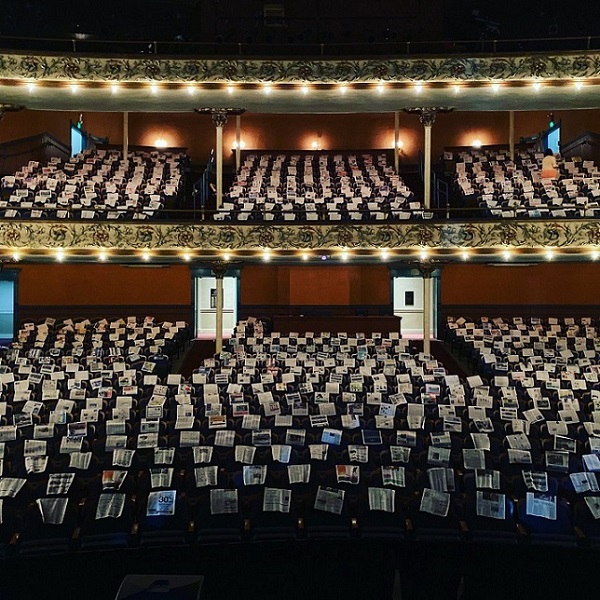So Drew McManus must be reading my mind, or at least my reading list. Yesterday I was reading an ArtsNet piece about an artist-in-residence program with the Philadelphia district attorney’s office that went on to mention other artist-in-residence programs sponsored by different governmental entities.
It reminded me of some of Drew’s past posts about how the bands of the various branches of the U.S. military were one of the many ways the government supports arts and culture outside the auspices of the National Endowment for the Arts.
What should happen today but Drew made a post about cultural diplomacy citing his past posts about military bands. I figured it was a sign that I should draw attention to the ArtsNet piece.
The main part of the article was about the Philadelphia district attorney’s artist-in-residence program which has the goal of stimulating conversations about criminal justice practices in the city.
The goal of the program is more in line with social practice art: to initiate conversations about the need for criminal justice reform, with an artist as moderator and interlocutor. “My presence in the prosecutor’s office sends a message to district attorneys, a powerful symbol of hope and redemption,” Hough said in an interview with Artnet News.
Through the program, prosecutors, victims and survivors of crime, and former convicted criminals will all take part in workshops, seminars, and other initiatives
[…]
Hough’s work at the district attorney’s office will involve more than just conversations and workshops. He plans to create a series of three-minute videos—“like a long-form commercial”—based on feedback from participants in the workshops and seminars, incorporating drawings he’ll make of those who took part. These videos will be shown at the district attorney’s office, on social media, and at the African American Museum in Philadelphia.
Some of the other artist-in-residence programs sponsored by governmental entities sound pretty interesting. I knew about the U.S. State Department’s cultural exchange program, but had no idea about some of these others. Makes me want to keep my eyes open for interesting opportunities.
The National Park Service brings in one artist at a time for a period of between two and five weeks. Residents are required to donate a piece of art that represents their stay to the Park Service’s collection, and they also may be asked to present a talk for park visitors.
“I just loved it,” said Kim Henkel, a metal sculptor in Denver, Colorado, who had been a resident at Mt. Rushmore, the Grand Canyon (“I was in a beautiful apartment overlooking the south rim”), and the Petrified Forest…
The US Military has more than just bands:
All five branches of the US Military also bring in artists—known as “combat” artists—for short-term (usually, a week or two at most) residencies on military bases or other locations where soldiers are stationed. The work they make on site is donated by the artists to the collections maintained by the respective branches.
…Military artists-in-residence are not told what or how to paint; they are not asked to be propagandists. Some of the artworks made in the past have focused on scenes that aren’t heroic or dramatic, including bored soldiers drifting off to sleep.
Many artists take part in these military programs just for the thrill of it. William Phillips, an artist in Ashland, Oregon whose specialty is aviation art, lights up when he talks about visiting an Air Force base, especially when describing taking a ride in a fighter jet: “Every time you get into a high-performance aircraft, you face danger. It’s not like sitting in my studio. And, when you put on that flight suit…”
US State Department’s program is actually more extensive than I was aware:
The US Department of State has its own residency program for artists too, called Arts Envoy…. Maxx Moses, a 57-year-old muralist and street artist living in San Diego, worked for a week in the city of Bulawayo, Zimbabwe, in 2011. …Moses led a team of 10 local artists in creating a series of murals on the theme of combating the AIDS epidemic. “Most of the artists had never worked with spray paint before or created in front of a live audience,” he said.
And perhaps the most unexpected program of all, the NYC Department of Sanitation:
And of course, perhaps the longest-running and most fabled artist-in-residence is Mierle Laderman Ukeles, who creates what she calls “maintenance art.” Since 1977, Ukeles has been the unsalaried artist-in-residence of the New York City Department of Sanitation. Among her artworks are a choreographed ballet of backhoes titled Romeo and Juliet and Touch Sanitation, an endurance performance that involved shaking hands with all 8,500 workers in the sanitation department while saying, simply, “thank you.”
Apropos to Drew’s post, you might have noted that a good number of these residencies are focused on using the soft-power influence of arts and culture to change perceptions and relationships where formal rules, processes, educational efforts, appeals to rational thinking, etc have fallen short.
You will likely also notice that in most instances, there isn’t a lot of payment involved, just food and shelter. Hopefully that might change if programs like the one in Philadelphia is perceived to have value.




I've been to a few of the Science on Tap events, though I never gave a talk at one of…